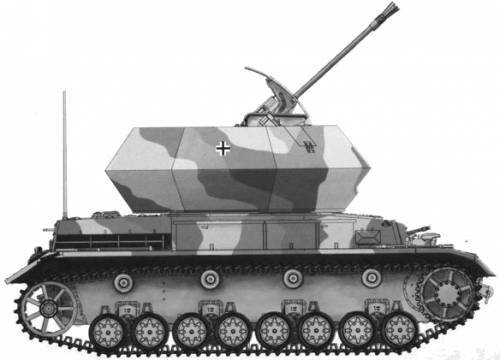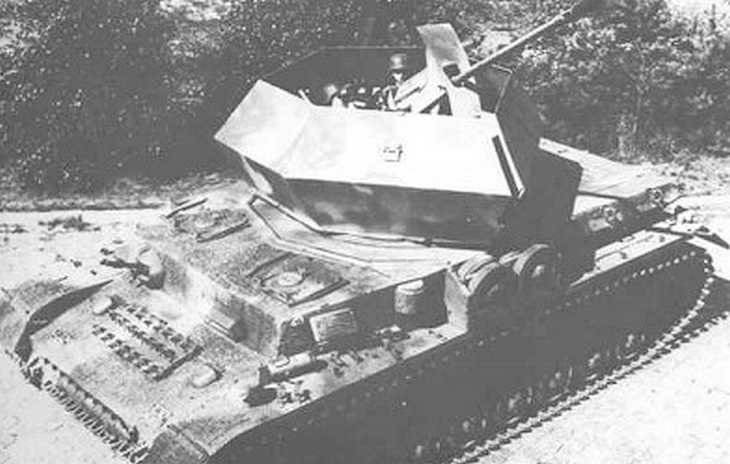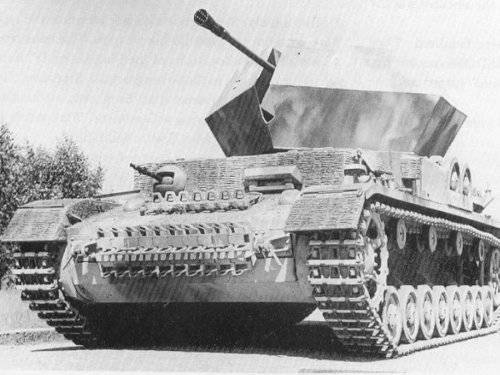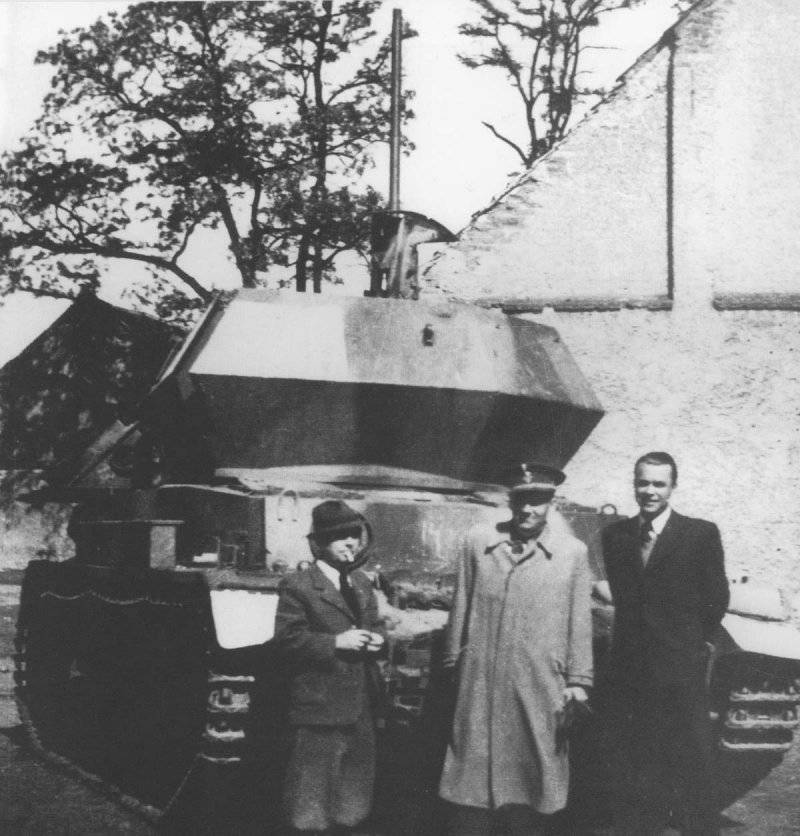ZSU "Ostwind"
The 1943 Summer Company of the Year was a major turning point in the entire Second World War. The collapse of the plans of the Nazis on the Kursk Bulge, the surrender of the colonial corps in Africa, the stormy onslaught of the Allied forces on Italian territory dramatically changed the military-strategic situation and severely undermined the military power of Nazi Germany. The occupying forces of the Fuhrer, on their own skin, felt that such is the domination of the enemy in airspace.

Capture air supremacy
The first to understand this were the regular German units and SS units on Italian soil, as the best parts of the German air force fought eastward. But even here the Luftwaffe aces did not do very well with the assigned missions - the Soviet troops managed, at the cost of incredible efforts and labor of the people in the rear, to provide advanced units and airfield service units with all necessary equipment and military equipment. By the beginning of the summer of 1944, the Yak-9D fighter was put into service with the Red Army, which was distinguished by strong weapons and high speed, which sharply reduced the capabilities of the aviation fleet Germany.
According to military historians, the unprecedentedly rapid completion of Operation Bagration on the territory of Belarus was largely due to the domination of Soviet pilots in the air. A number of large defensive structures of the Germans were practically wiped out under the blows of bomber and attack aircraft of the Red Army. The case has not yet reached the complete defeat of the Hitler troops, the leadership of the military-industrial complex and the militarist, aggressively-minded circles of major industrialists intervened. In a situation where the enemy took possession of the sky, the fact that the Wehrmacht’s anti-aircraft self-propelled guns (ZSU), anti-aircraft artillery fighting vehicles, which were quickly transferred to the combat position from the marching, gained special importance. Just in 1944, the Wehrmacht taught several types of new combat vehicles at once.
New weapons of the German Wehrmacht
In fairness, it must be said that almost from the beginning of World War II the Hitlerite military command was developing methods of defensive actions of its troops from air raids aviation the enemy. But the clear superiority in the air, especially at the beginning of operations on the Eastern Front, played a cruel joke with the Germans. Until the end of 1943, it was still somehow possible to cope with the help of unarmored ZSU and towed anti-aircraft guns, and in 1944 the military-strategic situation required immediate decisions. The task of ensuring the required density of anti-aircraft artillery fire had to be solved both on the march and in the areas of firing positions. Armed with ZSU weakly met the requirements put forward due to the unreliability of the protection of fire crews and combat systems (on the battlefield they remained defenseless). For military operations required ZSU with protection from fragments and large-caliber bullets, while the anti-aircraft gun should be installed on a rotating turret of a combat vehicle. Such products have already been developed by German designers and called Flakpanzer - anti-aircraft tank, according to the then existing terminology.
The base for the 20-mm anti-aircraft gun was the Pz Kpfw I tank, which was withdrawn from service by 1944 - its use was doubtful. ZSU also served as a base Tanks Pz 38 (t) and Pz Kpfw IV, however, despite the use of the tank base, the weak armor protection here was only in the stowed position, and in combat, the anti-aircraft gun was still defenseless.

The work of the firm "Ostbau"
Further, the Ostbau company advanced in solving this problem, which used the Pz Kpfw IV chassis restored after the fighting to create its own ZSU.
At the base of this product was installed tower anti-aircraft gun. Depending on the caliber of the gun, the anti-aircraft tank is called the Wirbelwind (with 20 mm guns), and with the 37-mm single gun - Ostwind
The firstborn Wirbelwind came off the assembly line in May, and Ostwind in July 1944.
Create ZSU Ostwind
Due to the large dimensions of the anti-aircraft tower, the attached Pz Kpfw IV base was not equipped with armored protection. The tactics of the ZSU at that time did not imply the presence of these systems in the first line of action of the military units, so the requirements for armor protection were significantly lower.
An open tower of complex configuration was mounted on a standard chassis, its armor was 25 mm around the perimeter. The tower was a 37-mm automatic flak43 L / 89 anti-aircraft gun, aiming devices, crew and part of the ammunition. The rest of the ammunition was in the under-drawer. The ZSU calculation consisted of a 6 man along with the gun commander. They took places inside self-propelled guns by analogy with the placement of the tank crew. Wirbelwind was equipped with a turret, which differed from the Ostwind modification. In total, Ostbau upgraded the Pz IV combat vehicles under FlakPz Ostwind and manufactured 33 new vehicles.
Combat use ZSU Ostwind
Currently, practically nothing is left in the Wehrmacht’s archives about the tactics and conditions of use of these self-propelled anti-aircraft installations. On various Internet portals, the evaluation of the effectiveness of the use of the Ostwind ZSU varies greatly, and evaluations are sometimes diametrically opposed. Researchers approach the presentation of this problem using various sources, some even simply refer to the need for them in the battle formations of the German army.
The 37-mm anti-aircraft gun had some advantages over the artillery systems that were very popular in the German troops 20 mm. The power of the 37-mm shot made it possible to counter the Soviet IL-2 and IL-10 aircraft, which could withstand the hit of 20-mm projectiles. A higher percentage of damage to the high-altitude targets of the ZSU Ostwind made it possible to use these complexes against targets at medium altitudes. The 37-mm anti-aircraft gun could be used in the fight against light and medium tanks. At the same time, the 37-mm anti-aircraft gun was inferior to the quad-rate 20-mm anti-aircraft systems in terms of the rate of fire, and, accordingly, could not counteract the infantry units as effectively as the 20-mm Flakfirlings.
Using Ostwind Prototypes
These systems took part in the Nazi Ardennes operation as part of the Leibstandart Adolf Hitler elite SS regiment. Despite the need for massive deliveries, the release of ZSU was limited. This is due to two reasons. The first is the evacuation of the equipment of the supplying companies of the Ostbau company under the threat of the seizure of factories by the advancing Soviet troops. The second is a collision in the leadership of the German Ministry of Arms. Some officials considered previously developed ZSU temporary anti-aircraft systems before adopting a new anti-aircraft tank, Kugelblitz on the same chassis Pz IV. However, the time the Red Army did not leave the Germans time, Kugelblitz never left the stage of prototypes
Conclusion
Flak Pz Ostwind can be called a unique system among all created anti-aircraft systems during the years of the Second World War. These developments exist only a few units among similar products with the same design and layout solutions. The bulk of the ZSU, which were in service with the allied forces, were semi-tracked armored personnel carriers. Our ZSU until the end of the war of the year were generally installing anti-aircraft guns on a truck. Sample ZSU T-90 (T-70 with two 12.7-mm machine guns DShK), although it passed the test tests, but the "series" did not go. Only by the beginning of 1945, the ZSU-37 was adopted by the anti-aircraft gun SU-76М for armament of anti-aircraft artillery.


Information